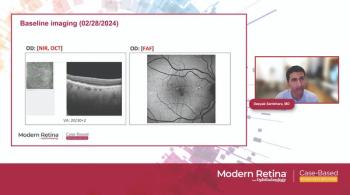
Results from preclinical study KIO-104 released
KIO-104 is a therapeutic candidate shown to significantly reduce retinal scar formation.
Kiora Pharmaceuticals recently announced the results from a preclinical study of KIO-104.1 The findings demonstrate the use of KIO-104 as a therapeutic candidate for the treatment of inflammatory and proliferative diseases of the retina, as it is shown to significantly reduce scar formation in an established in vivo model of proliferative vitreoretinopathy (PVR), according to a press release.1
KIO-104, a small molecular DHODH inhibitor, works by suppressing T cell replication and function. The suppression of T cell numbers and activity could offer a novel approach when reducing or eliminating the underlying proliferative and inflammatory environment that leads to retinal scarring.
Romana Seda-Zehetner, MSc, MScTox, Koira’s director of preclinical development, gave a presentation at the 2025
Using subretinal injection of hyaluronic acid into the right eye, retinal detachments were induced in Dutch Belted rabbits. This retinal detachment model in rabbits mimics the structural and function disruption observed in human retinal detachment, including glial reactivity, subretinal fibrosis, immune cell infiltration, and glial scar formation.1 There was both a high dose and a low dose group.
The findings of this preclinical study of KIO-104 include:
- All 6 rabbits in the high dose group exhibited complete prevention of scar formation.
- Of the 6 rabbits in the low dose group, 2 developed a total of 9 retinal scars, as well as a significant reduction in mean ± SEM scar length to 43 ± 16 µm.
- Four of the 6 rabbits in the control group exhibited scar formation, which resulted in 20 retinal scars with a mean ± SEM scar length of 110 ± 28 µm.
“PVR is the leading complication following retinal detachment surgery,” said Eric J. Daniels, MD, chief development officer for Kiora, in a press release. “This condition is driven by uncontrolled cellular proliferation, fibrosis, and inflammation. This results in scarring which may lead to repeated retinal detachments, as well as progressive and permanent loss of vision. Given the reduction in scar formation and scar size observed in this study, and the fact that there are no approved drugs for this condition, further development of KIO-104 in PVR is warranted.”
KIO-104 is being evaluated in a phase 2 clinical trial in patients with macular edema.1
Reference:
1. Kiora Pharmaceuticals, Inc. Kiora Pharmaceuticals Presents In Vivo Preclinical Data at ARVO 2025 Demonstrating the Potential of KIO-104 to Treat Proliferative Vitreoretinopathy. Newsfile. Published 2025. Accessed May 5, 2025. https://www.newsfilecorp.com/release/250663/Kiora-Pharmaceuticals-Presents-In-Vivo-Preclinical-Data-at-ARVO-2025-Demonstrating-the-Potential-of-KIO104-to-Treat-Proliferative-Vitreoretinopathy
Newsletter
Keep your retina practice on the forefront—subscribe for expert analysis and emerging trends in retinal disease management.








































